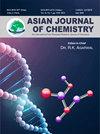Characterization of Degradation Products of Selpercatinib by Mass Spectrometry: Optimization of Stability-Indicating HPLC Method for Separation and Quantification of Process Related Impurities of Selpercatinib
Q4 Chemistry
引用次数: 0
Abstract
The study aimed to investigate a novel approach by utilizing liquid chromatography in coupled with mass spectrometry (LC-MS) to resolve, analyze and characterize significantly less quantity of stress degradation products (DPs) of selpercatinib along with its process related impurities. The analytes resolved on ZORBAX Eclipse (250 mm) stationary phase that was maintained employing 0.5 M sodium perchlorate at pH 5.4 methanol and acetonitrile in 50:20:30 (v/v) pumped at 0.8 mL/min isocratic flow and 241 nm wavelength. The method produces very high correlate linear curve in 30-240 μg/mL for selpercatinib and 0.03-0.24 μg/mL for its impurities with significantly low detection limit of 0.01 μg/mL for impurities. Selpercatinib pure compound was subjected to stress studies and chromatographic results confirm the formation of four DPs, which were characterized with the interpretation of their mass fragmentation pattern. The DPs were identified as 6-hydroxy-4-(6-(6-((6-methoxypyridin3-yl)methyl)-3,6-diazabicyclo[3.1.1]heptan-3-yl)pyridin-3-yl)pyrazolo[1,5-a]pyridine-3-carbonitrile (DP 1), 6′-(6-((6-methoxypyridin-3-yl)methyl)-3,6-diazabicyclo[3.1.1]heptan-3-yl)-1,2-dihydro-[3,3′-bipyridin]-5-ol (DP 2), (6-hydroxy-4-(6-(6-(pyridin-3-ylmethyl)-3,6-diazabicyclo[3.1.1]heptan-3-yl)pyridin-3-yl)pyrazolo[1,5-a]pyridine-3-carbonitrile (DP 3), 1-amino-6′-(6-((6-methoxypyridin-3-yl)methyl)-3,6-diazabicyclo[3.1.1]heptan-3-yl)-1,2-dihydro-[3,3′-bipyridin]-5-ol (DP 4), 6-(2-hydroxy-2-methyl-propoxy)-4-(6-(3-methylpiperazin-1-yl)pyridin-3-yl)pyrazolo[1,5-a]pyridine-3-carbonitrile (DP 5) and 6-(2-hydroxy-2-methyl-propoxy)-4-(6-(3-methylpiperazin-1-yl)pyridin-3-yl)pyrazolo[1,5-a]pyridine-3-carbonitrile (DP 6). Based on findings, it was concluded that this method was effectively applied for the regular quantification of impurities of selpercatinib in formulations. Additionally, it demonstrated applicability for the identification of both known and unknown impurities of selpercatinib.赛乐替尼降解产物的质谱表征:优化用于分离和定量色瑞帕替尼工艺相关杂质的稳定性指示高效液相色谱法
该研究旨在探索一种新方法,即利用液相色谱-质谱联用技术(LC-MS)来解析、分析和表征数量明显较少的赛铂替尼应激降解产物(DPs)及其工艺相关杂质。分析物在 ZORBAX Eclipse(250 毫米)固定相上解析,该固定相采用 0.5 M 高氯酸钠,pH 值为 5.4,甲醇和乙腈的比例为 50:20:30(v/v),泵速为 0.8 mL/min,等度流动,波长为 241 nm。该方法在30-240 μg/mL范围内对色瑞帕替尼产生了很高的线性相关曲线,对其杂质产生了0.03-0.24 μg/mL的线性相关曲线,杂质的检出限低至0.01 μg/mL。对色瑞帕替尼纯化合物进行了应力研究,色谱结果证实形成了四种DPs,并通过解释其质量碎片模式对其进行了表征。这些 DPs 被鉴定为 6-羟基-4-(6-(6-((6-甲氧基吡啶-3-基)甲基)-3,6-二氮杂双环[3.1.1]庚烷-3-基)吡啶-3-基)吡唑并[1,5-a]吡啶-3-甲腈(DP 1)、6′-(6-((6-甲氧基吡啶-3-基)甲基)-3,6-二氮杂双环[3.1.1]heptan-3-yl)-1,2-dihydro-[3,3′-bipyridin]-5-ol (DP 2), (6-hydroxy-4-(6-(6-(pyridin-3-ylmethyl)-3,6-diazabicyclo[3.1.1]庚烷-3-基)吡啶-3-基)吡唑并[1,5-a]吡啶-3-甲腈(DP 3)、1-氨基-6′-(6-((6-甲氧基吡啶-3-基)甲基)-3,6-二氮杂双环[3.1.1]heptan-3-yl)-1,2-dihydro-[3,3′-bipyridin]-5-ol (DP 4), 6-(2-hydroxy-2-methyl-propoxy)-4-(6-(3-methylpiperazin-1-yl)pyridin-3-yl)pyrazolo[1,5-a]吡啶-3-甲腈(DP 5)和 6-(2-羟基-2-甲基丙氧基)-4-(6-(3-甲基哌嗪-1-基)吡啶-3-基)吡唑并[1,5-a]吡啶-3-甲腈(DP 6)。结果表明,该方法可有效地用于制剂中舍培拉替尼杂质的定量分析。此外,该方法还适用于识别赛哌卡替尼的已知和未知杂质。
本文章由计算机程序翻译,如有差异,请以英文原文为准。
求助全文
约1分钟内获得全文
求助全文
来源期刊

Asian Journal of Chemistry
化学-化学综合
CiteScore
0.80
自引率
0.00%
发文量
229
审稿时长
4 months
期刊介绍:
Information not localized
 求助内容:
求助内容: 应助结果提醒方式:
应助结果提醒方式:


